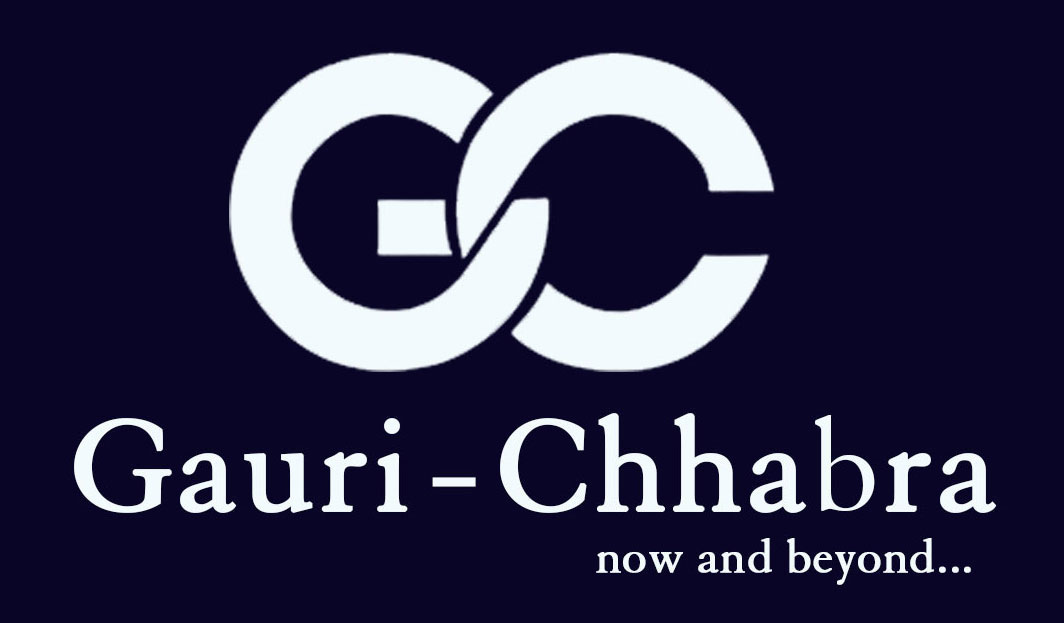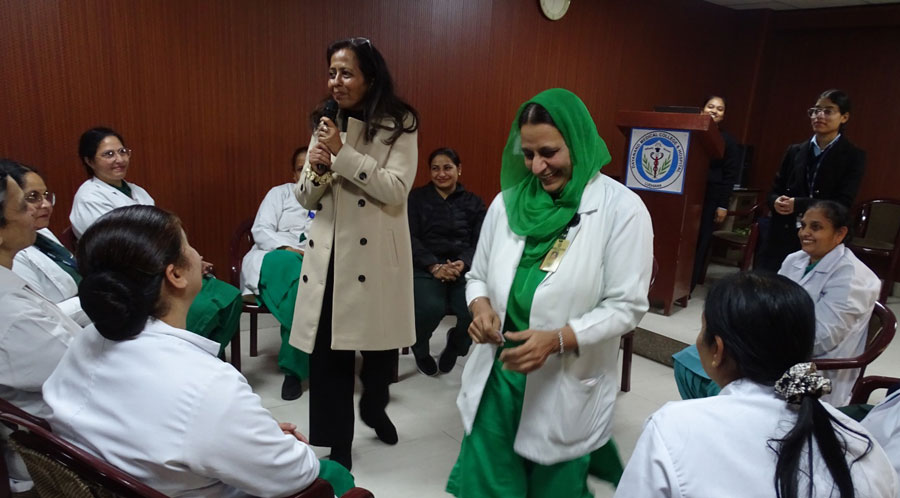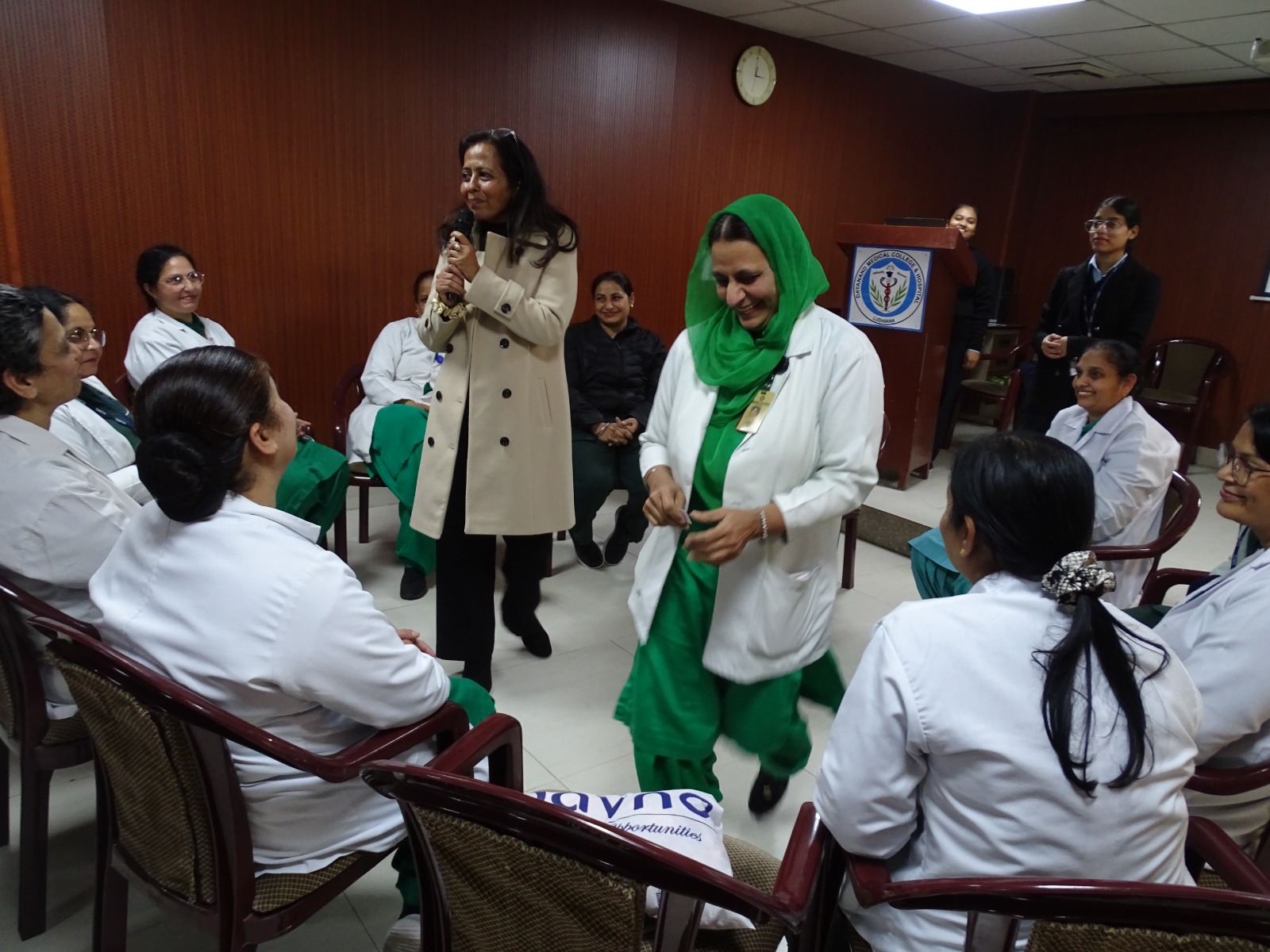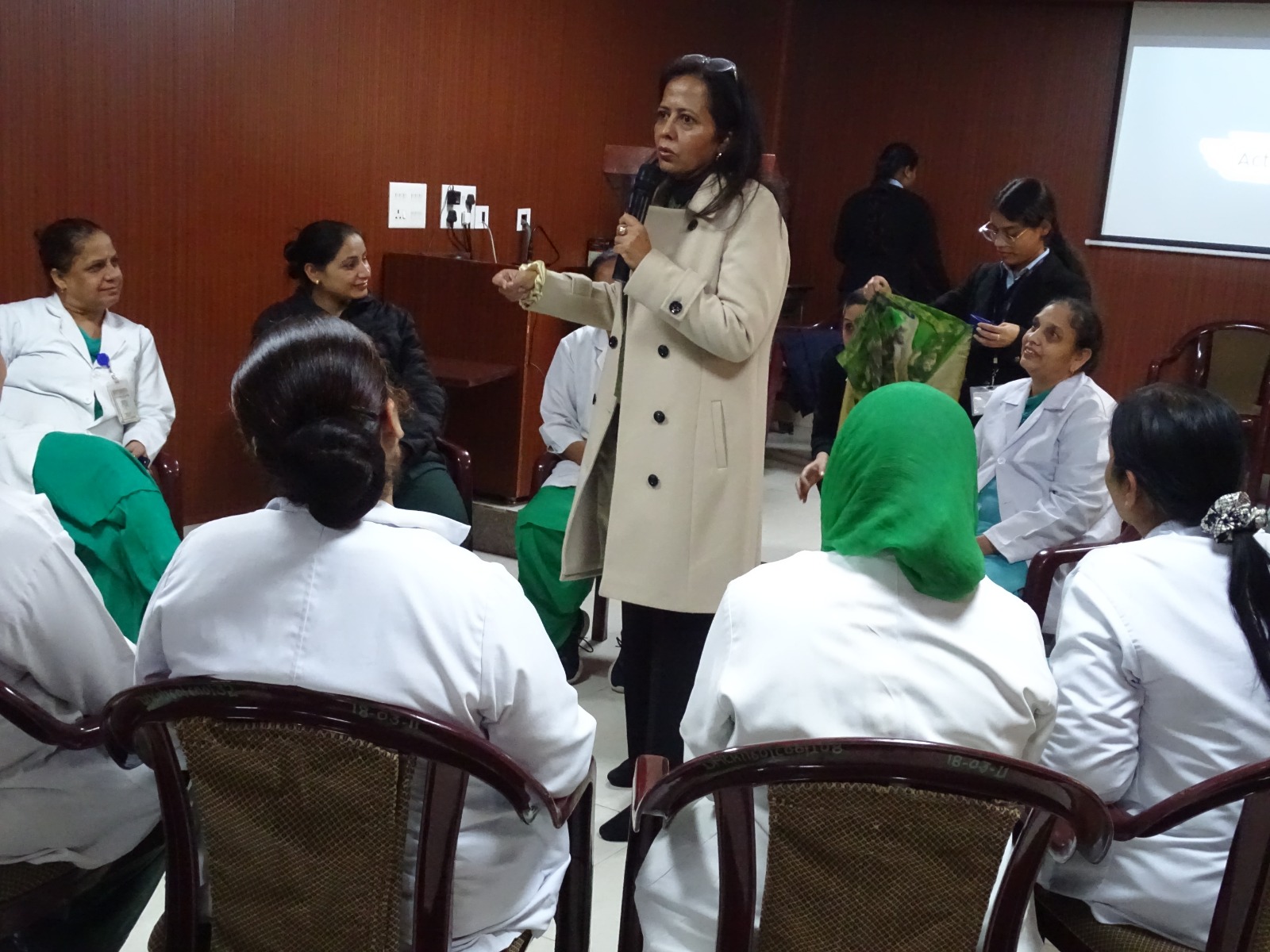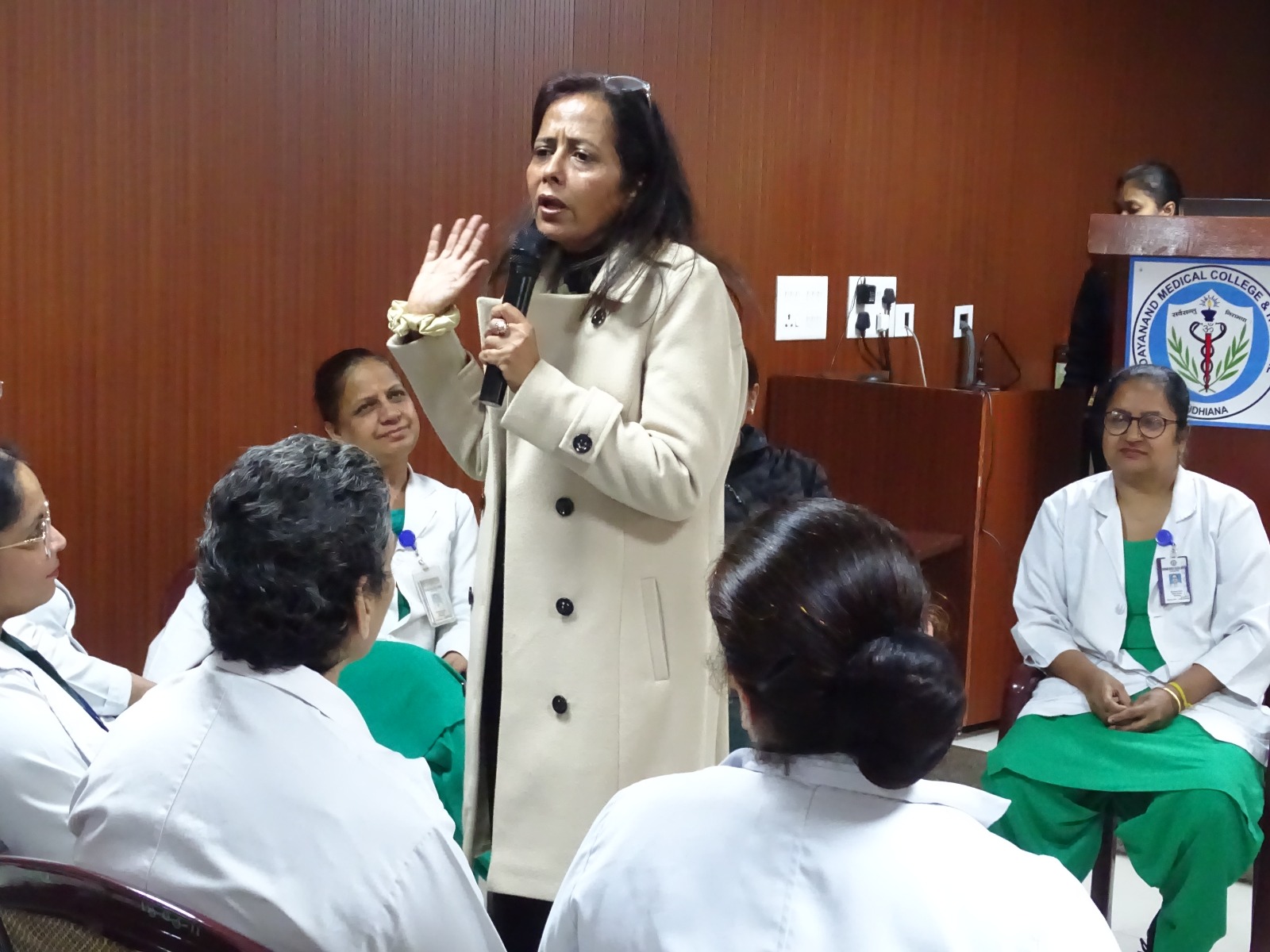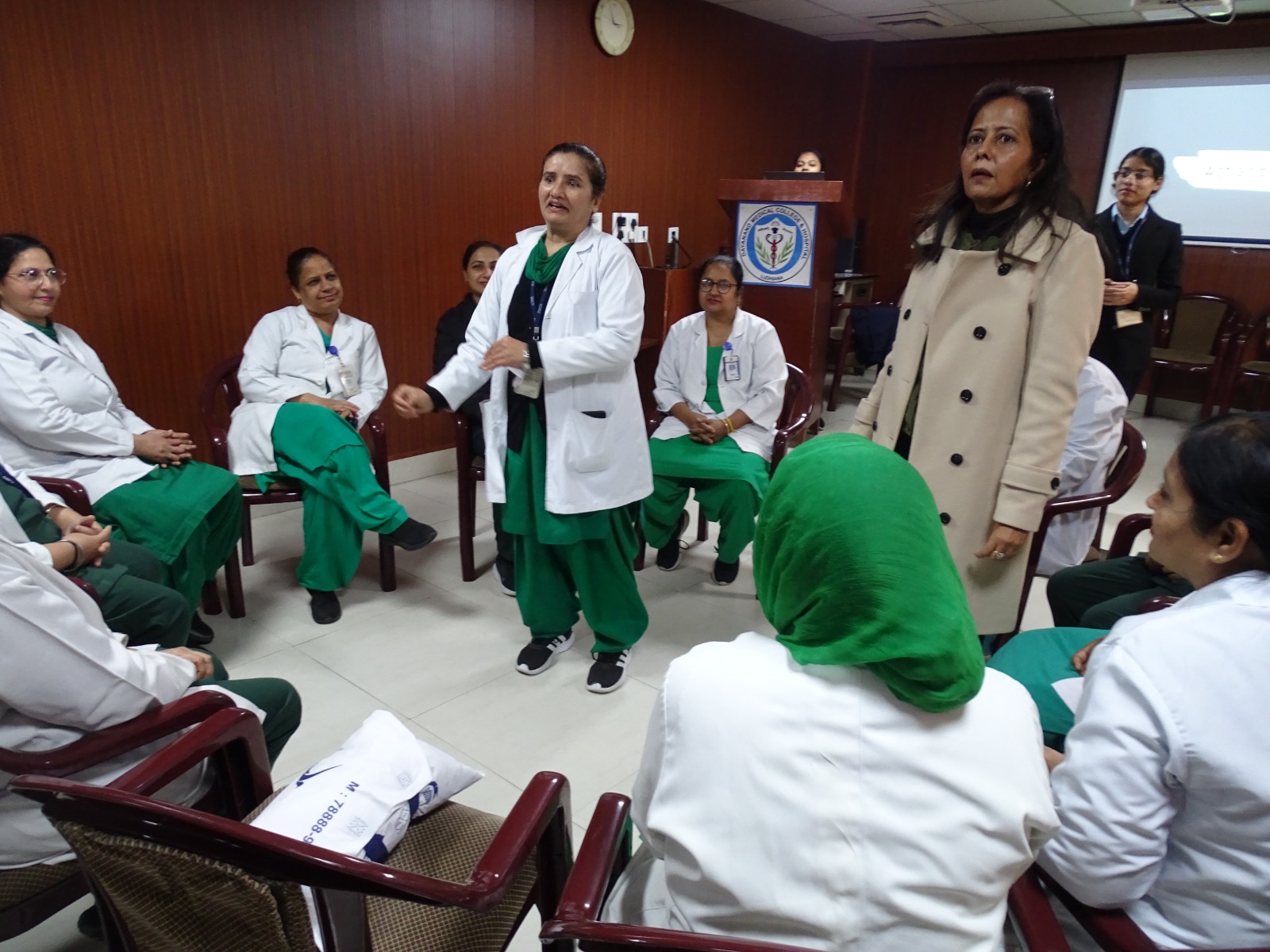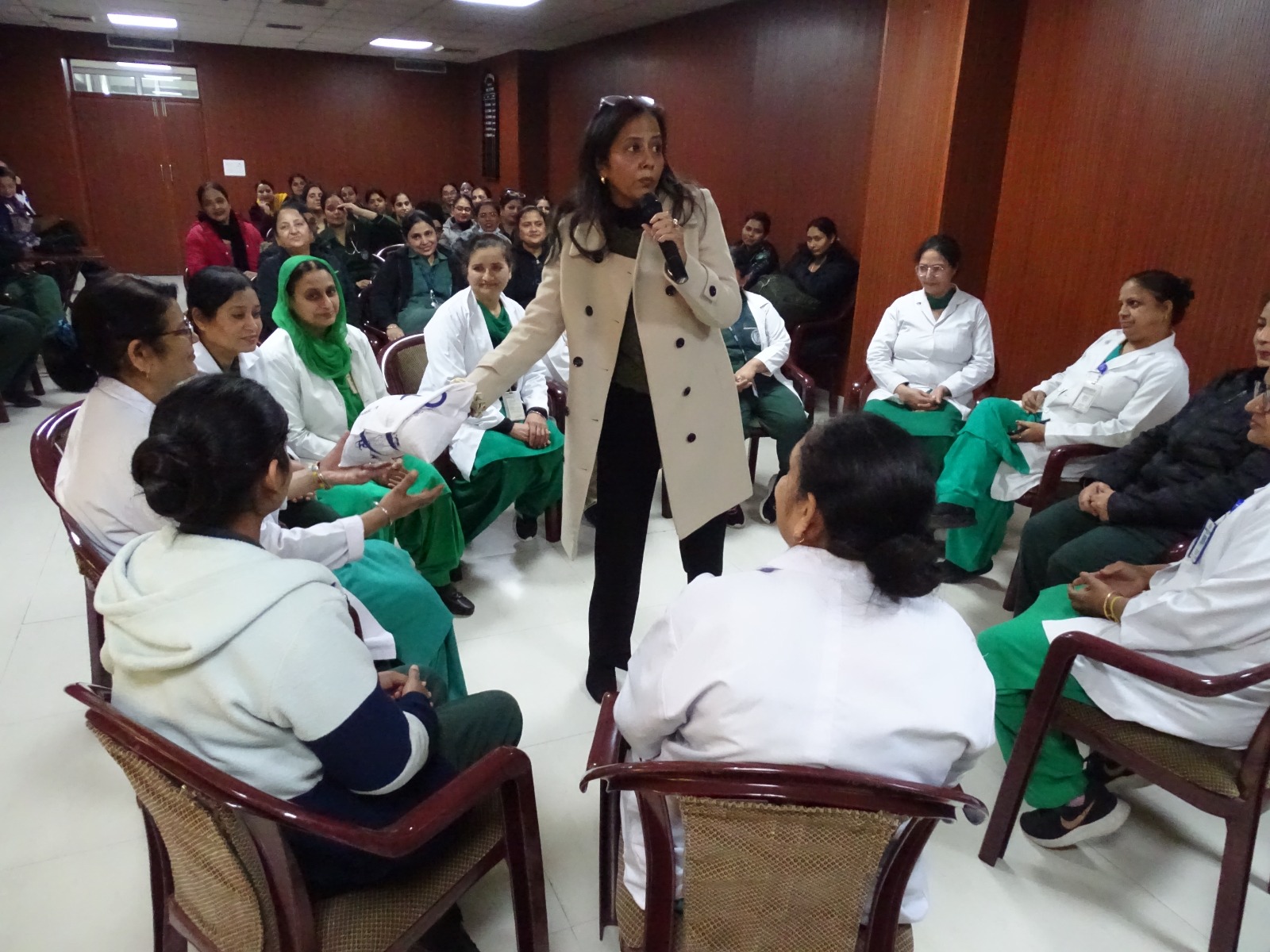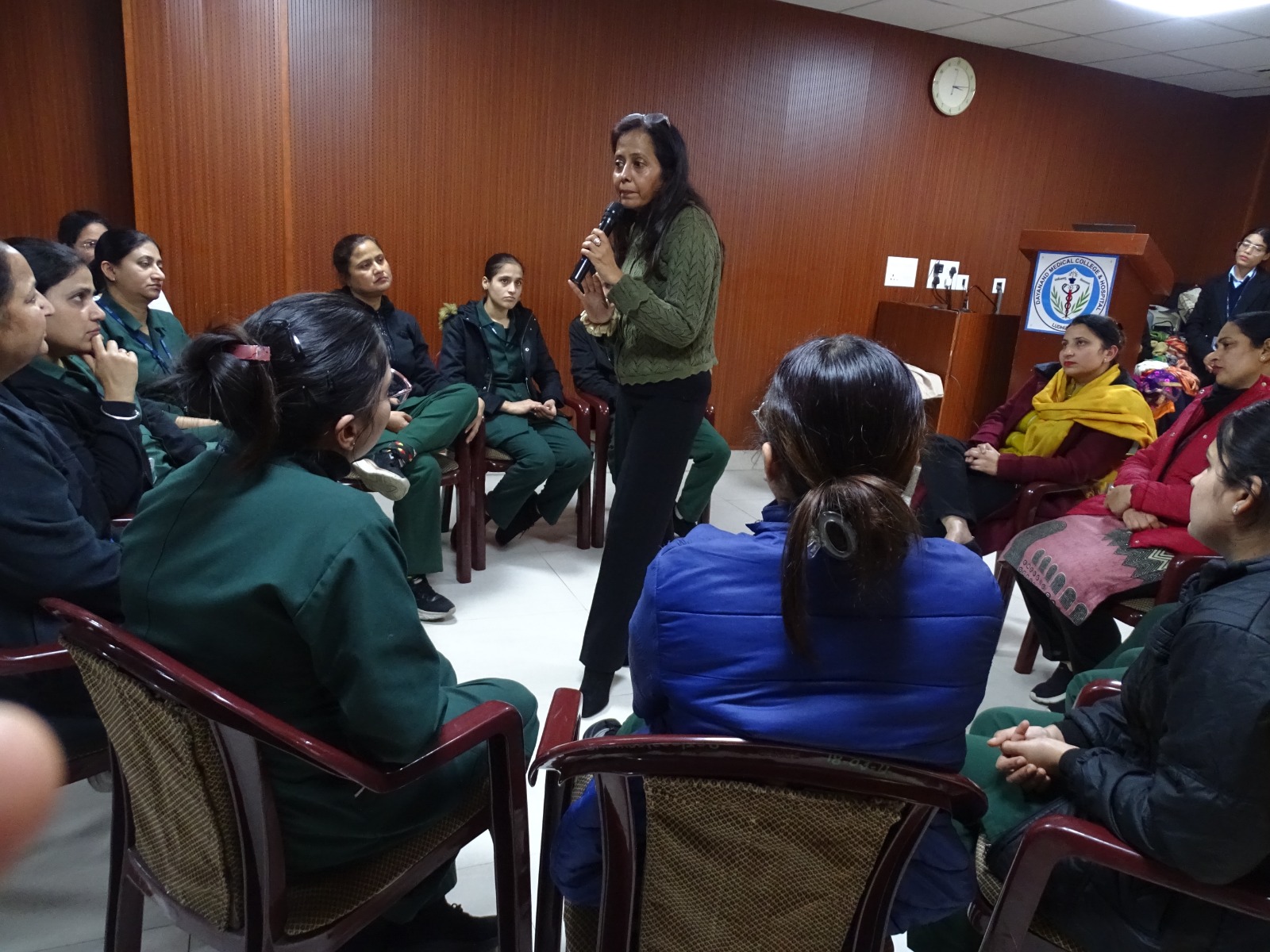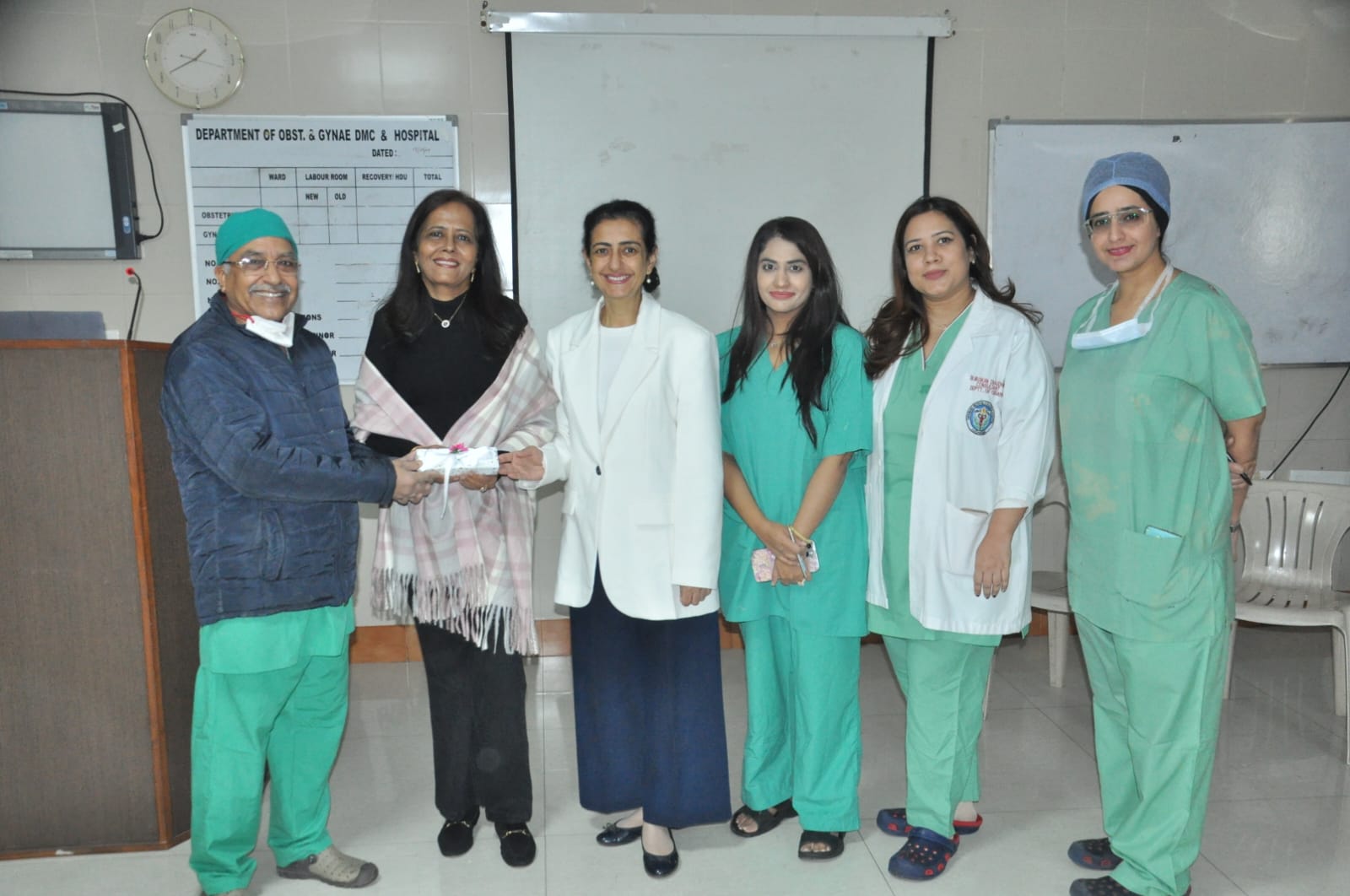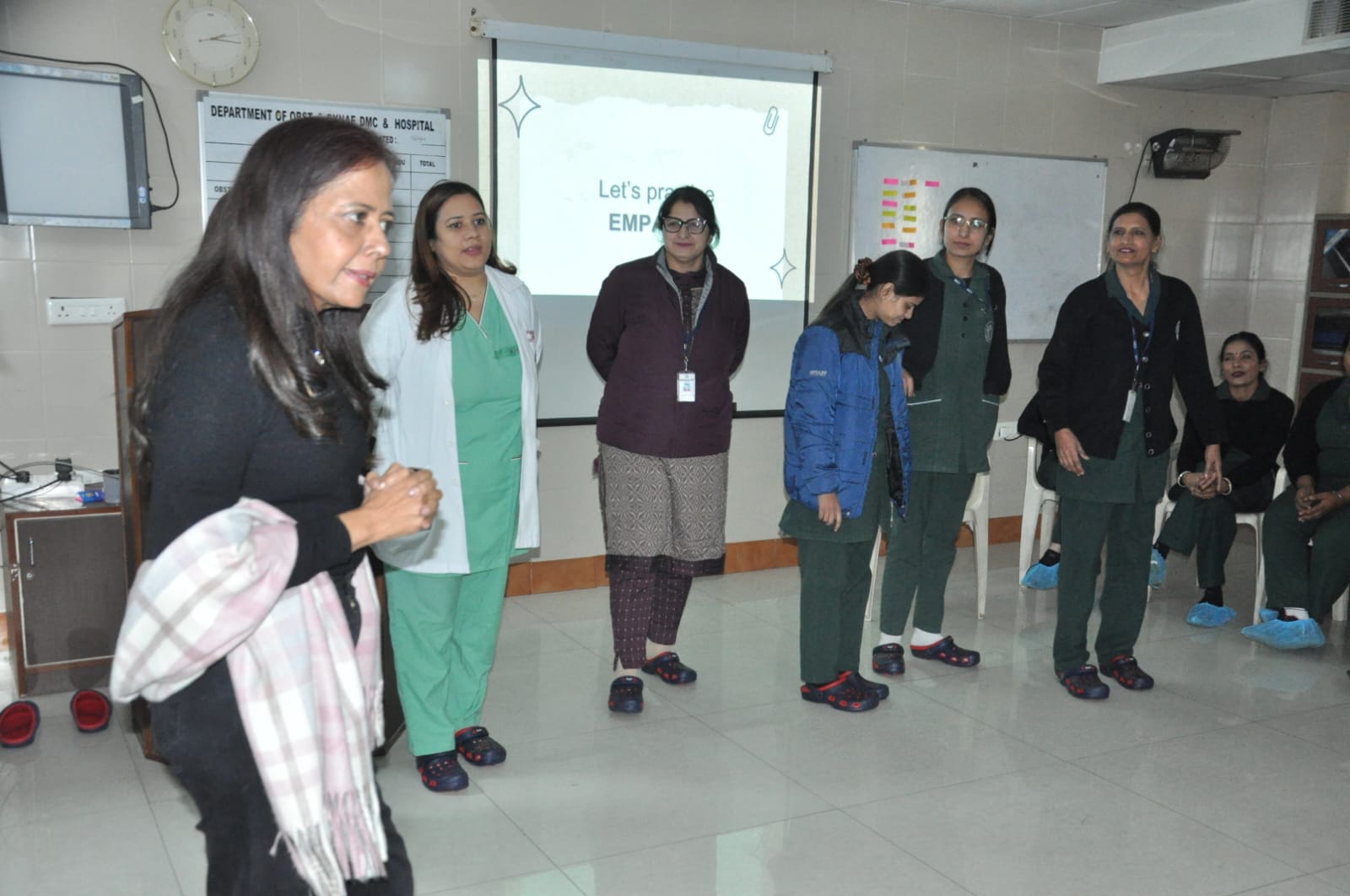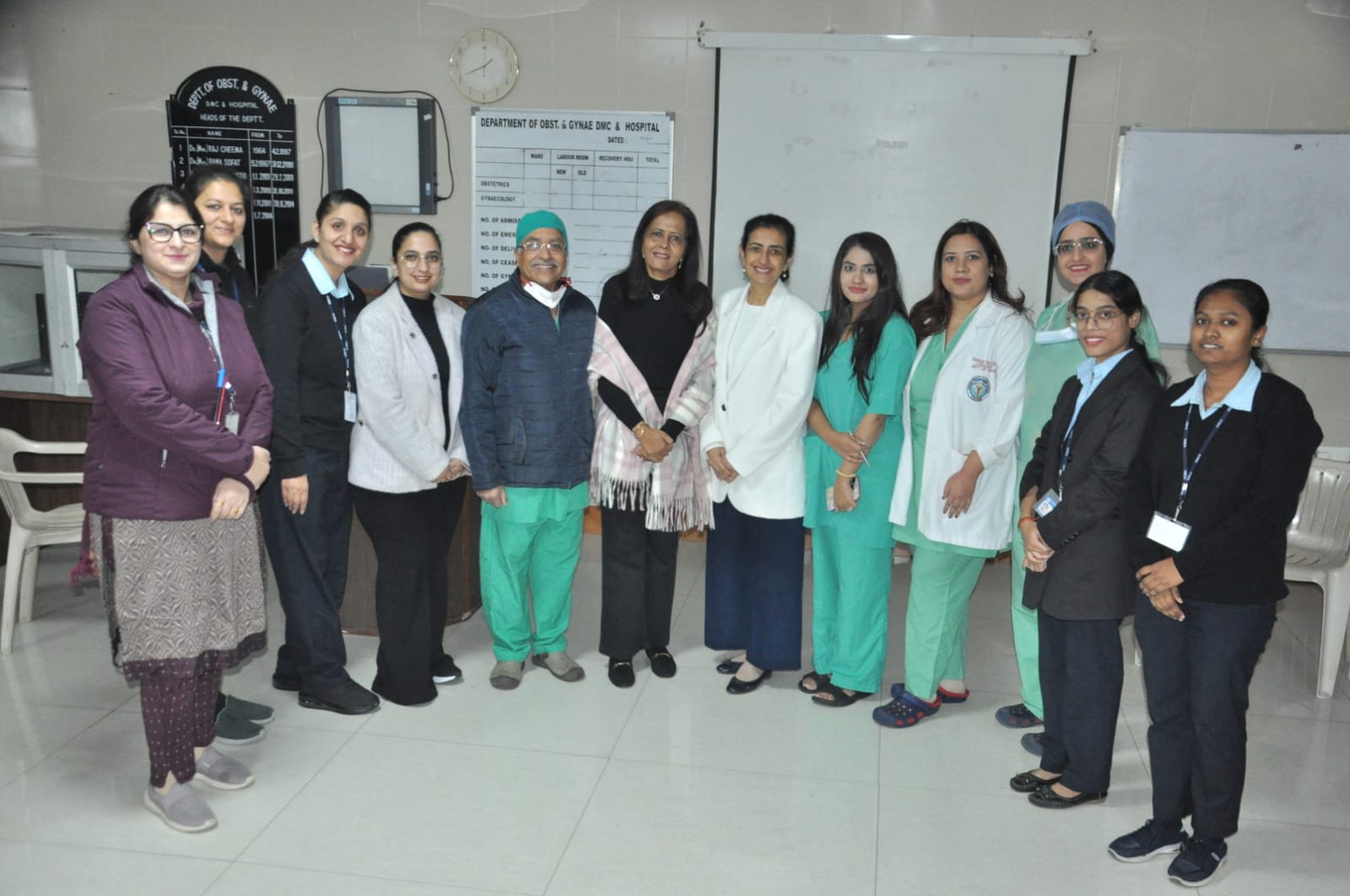Gauri Chhabra recently conducted a transformative training session on ‘Clinical Empathy’ for the nursing staff at DMC and H Emergency. The session emphasized the pivotal role of empathy in enhancing patient care and fostering effective communication in high-pressure environments. Through interactive activities and real-world scenarios, the training empowered nursing professionals to better understand patient needs and emotions, ultimately leading to improved patient outcomes. Gauri Chhabra’s expertise in bridging emotional intelligence with clinical excellence resonated deeply with participants, inspiring them to integrate empathy into their daily practices. This initiative reflects her commitment to nurturing compassionate, patient-centered healthcare professionals.
 admin
admin

The New You (DMC & H Ludhiana)
The New You, a motivational event hosted by Gauri Chhabra at Dayanand Medical College & Hospital (DMC&H), Ludhiana, inspired participants to unlock their true potential. Through impactful storytelling, practical insights, and engaging activities, Gauri empowered individuals to embrace change, overcome challenges, and embark on a journey of personal growth and self-discovery.

The Civil Services
- a preliminary examination consisting of two objective-type papers (general studies and aptitude test), and
- a main examination consisting of nine papers of conventional (essay) type, followed by a personality test (interview).
Stage I: Preliminary examination – A qualifying test advertisied in Feb-March and held in June-July each year. Results are published in mid-August.
Stage II: Main examination – Held in October every year. Results are usually published in the second week of March.
Stage III: Personality Test (interview) – held in December each year. Final results are usually announced in May .
The candidate must have attained the age of 21 years and must not have attained the age of 32 years (for the General category candidate) on August 1 of the year of examination. Prescribed age limits vary with respect to caste reservations.
General category candidates = 6.[6]
In the initial stages of their career, IAS officers join as the Sub-Divisional Magistrates (SDM) in a state and go on to occupy positions such as District Magistrate, Divisional Commissioner, etc. They are appointed as the heads of Government Organizations, Public Service Undertakings and also act as Secretary to the Government of India.

Amplify YOU workshop for working professionals
Gauri Chhabra recently hosted the “Amplify YOU” workshop for working professionals, designed to empower individuals in enhancing their personal and professional growth. This dynamic session focused on building self-confidence, effective communication, and leadership skills, crucial for navigating today’s competitive work environment. Attendees were engaged in interactive activities, self-assessment exercises, and actionable strategies for achieving success in their careers. Gauri’s expertise in life coaching and career development provided valuable insights into overcoming challenges, setting clear goals, and maximizing potential. Participants left feeling energized and equipped to take control of their personal and professional journeys.
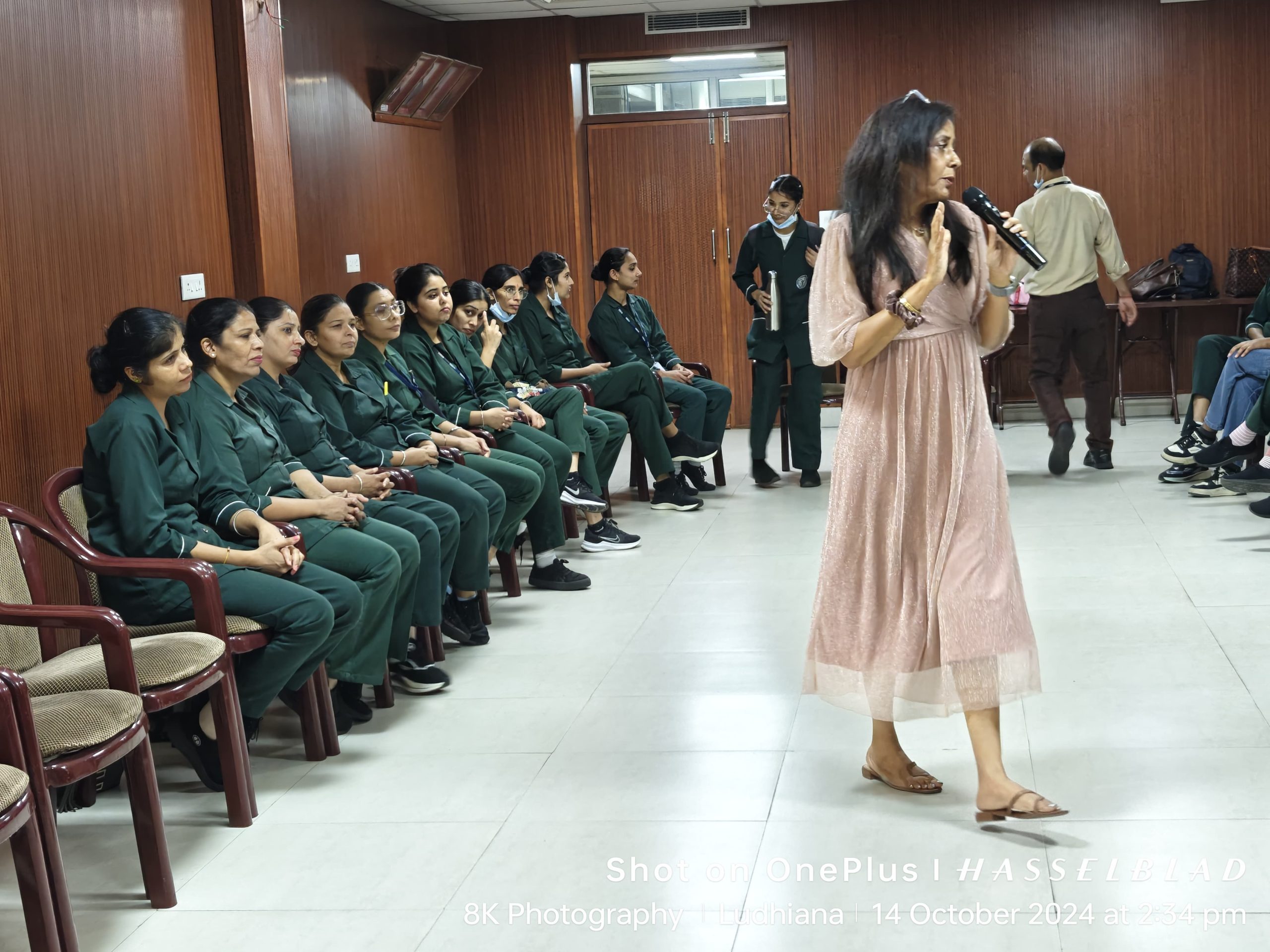

Beyond the sky
A few months ago, Chandrayaan-2 was a giant leap towards space exploration, putting ISRO, the Indian Space Research Organization, on a coveted position in the world map. ISRO calls for a bent of mind that fosters a craving for exploration and discovery, application of the advancement of technology, attempt to simulate life beyond orbits, and build a global fraternity in space.
About ISRO
The Indian Space Research Organisation (ISRO), established on 15 August 1969, is under the administrative umbrella of the Department of Space, Government of India. Over the past decade or so, ISRO has carved a niche for itself in the space exploration horizon owing to its constant endeavors to explore space and orbits. Indian Space Research Organisation works with many offshoots such as communication satellites and remote sensing satellites, thus necessitating the spiral demand for fast and reliable communication and earth observation products. It is also responsible for the advanced applications that are helpful for the country in its decision making process such as services like weather forecast, Geographical online information, scientific navigation and the like.
Entry and Career Options:
Depending on the post, your eligibility can be SSC, diploma, undergraduate degree or a doctorate in the relevant discipline
After XII : To become a scientist at ISRO, you are required to have Math and Physics as subjects at 10+2 level.You should crack IIT-JEE and get admission into IIST, maintain a decent CGPA and get absorbed into ISRO
After Graduation: After completing B.Tech from any college, an examination namely ICRB (centralized Recruitment Bangalore) is conducted by ISRO and you would be tested as per your respective branches of engineering and after clearing the interview, you can become a scientist at ISRO. You must have a minimum aggregate percentage of 65% and above in B.tech in their respective relevant streams. After Post Graduation You can also enter after the post graduate degree or D. in trades such as Geoinformatics, Remote Sensing, Instrumentation, applied Mathematics, Geophysics, Geography or any other equivalent degree in the field of Physics or Mathematics.
You may join as scientist, technician, technical assistant, admin officers, purchase officers, etc. depending on eligibility.
ISRO Recruitment 2020:
Indian Space Research Organisation (ISRO) ISRO SAC– Space Application Centre has released the job notification for the post of Scientist/Engineer, Technical Assistant, Technician – 55 vacancies. Candidates with the qualification of M.E/ M.Tech/ M.Sc/ Ph.D/ Diploma/ ITI are eligible to apply for this job. The selection process is based on the Written Test and Skill Test. Interested and eligible candidates can apply online through ISRO SAC website on or before 3 April 2020, however, the date has been extended to 01 May 2020.
ISRO Recruitment 2020:
Indian Space Research Organisation (ISRO) ISRO SAC– Space Application Centre has released the job notification for the post of Scientist/Engineer, Technical Assistant, Technician – 55 vacancies. Candidates with the qualification of M.E/ M.Tech/ M.Sc/ Ph.D/ Diploma/ ITI are eligible to apply for this job. The selection process is based on the Written Test and Skill Test. Interested and eligible candidates can apply online through ISRO SAC website on or before 3 April 2020, however, the date has been extended to 01 May 2020.
Number of posts:
- Scientist/Engineer-SD: 2 Posts
- Scientist/Engineer-SC: 19 Posts
- Technical Assistant: 6 Posts
- Technician/Draughtsman-B:28 Posts
- For Scientist/Engineer-SD(Electronics): There is no age limit for Scientist/Engineer-SD. As far as educational qualification is concerned, you need to be
- Phd. in fields related to Electronics/ Communication/RF & Microwaves /Power Electronics/ VLSI Design/ Micro Electronics/ Embedded Sys./Signal Processing (OR)
- M.E./M.Tech. in Electronics / Electronics & Communication / Electronics & Electrical Engineering / Information & Communication Technology (ICT) with Specialization in Electronics / Communication/ RF & Microwaves / Power Electronics / VLSI Design / Micro Electronics / Embedded Sys. / Signal Processing AND Minimum 02 years of professional experience after acquiring the Degree of M.E./M.Tech.
- Scientist/Engineer-SC : For Scientist/Engineer-SC(Physics), you need to be an M.Sc. in Physics
Scientist/Engineer-SC(Computer)
- Scientist/Engineer-SC(Computer) : M.E. / M.Tech. in Computer Science / Computer Engineering / Computer Science & Engineering / Information and Communication Technology (ICT), with Specialization in Artificial Intelligence / Machine Learning / Deep Learning / Image Processing (OR)with Specialization in IT Security / Cyber Security
- Scientist/Engineer-SC(Electronics) : M.E./M.Tech. in Electronics / Electronics and Communication / Electronics & Electrical Engineering / Information and Communication Technology (ICT) with Specialization in Electronics / Communication / RF & Microwaves / Power Electronics / VLSI Design / Micro Electronics / Embedded Sys. / Signal Processing
- Scientist/Engineer-SC(Mechanical) : M.E./M.Tech. in Mechanical Engineering with Specialization in Thermal Engineering / Structural Engineering / Structural Analysis / Material Science / Material Technology / CAD / CAE / Design Engineering / Industrial Safety Engineering
- Scientist/Engineer-SC(Structural) : M.E./M.Tech. in Structural Engineering / Civil Engineering with Specialization in Structural Engineering
- Scientist/Engineer-SC(Electrical) : M.E./M.Tech. in Electrical Engineering For Scientist/Engineer-SC/SD you should have an aggregate minimum of 60% or CGPA / CPI grading of 6.5 on a ten scale. Work profile: As a Scientist/Engineer ‘SC’, your work will be to design, develop and test different systems which will be used in either ongoing or future projects related to ISRO. All new recruits would be required to attend a 2 month Induction Training Program. The first part is the General Module held for all new recruits and the second part is the Area Specific Module where engineers are segregated based on their centres or areas e.g. Spacecraft, Launch Vehicles, Applications etc.
- ForTechnical Assistant , you need to have a Diploma in Electronics / Electronics and Communication /Mechanical/Civil/Electrical Engineering in FIRST CLASS from recognized Board /University.
- For Technician-B/Draughtsman-B, you can be : Technician B vacancies, candidates with a Matric (SSC / SSLC / 10th Class) as well as ITI, NTC or NAC in the following trades can apply: Fitter (6 vacancies), Machinist (3 vacancies), Electronics (10 vacancies), Information Technology (2 Vacancies), Plumber (1 vacancy), Carpenter (1 vacancy), Electrician (1 vacancy), Mechanical (3 vacancies), and Chemical (1 vacancy).
Pay Scale:
- Scientist/Engineer-SD: ₹ 67,700–₹ 2,08,700- Level 11
- Scientist/Engineer-SC: ₹ 56,100–₹ 1,77,500- Level 10
- Technical Assistant: ₹ 44,900–₹ 1,42,400- Level 7
- Technician/Draughtsman-B: ₹ 21,700–₹ 69,100- Level 3
Selection Process:
Scientist/Engineer-SD/SC: The selection process is based on the written test.
Technical Assistant/Technician: The selection process is based on the written test & Skill test.Written Test will be conducted in such a way that theoretical and practical knowledge of the candidate is tested covering both breadth and depth of the prescribed curriculum. The written test shall serve as a qualifying test in the sense that on the basis of the written test scores, you would be called for a skill test. The skill test will be purely on ‘go-no-go’ basis and marks obtained in the skill test will not be considered for selection. The skill test will be evaluated on a 100-point scale with a minimum 60% for qualification.
How to Apply
- Download the ISRO URSC notification.
- Read all the details and apply if you are eligible
- If eligible, click the ISRO URSC apply online link
- Start filling all the details asked for
- Make sure you attach documents in the prescribed format
- Pay the application fee as applicable
- Click on submit to complete your URSC Recruitment process
- Take a print out of the application form and capture the unique applicant ID for future reference
Conclusion:
Therefore, if you wish to dream big and reach beyond the sky, gear yourself up for space organization of the day, ISRO.
The rest will be history.

Wonders with Water
What is Oceanography?
“Oceanography, also known as oceanology is the field of earth science that includes the study of ocean currents, waves, geology of the sea floor, physical properties within the ocean and across its boundaries. It is the study of all things that is related to ocean.” In simple words, Oceanography is the “study of oceans”. Oceanographers are the scientists who study the ocean. They are involved in mineral exploitation, shipping, fisheries, coastal construction, weather prediction and climate change. There are many branches of oceanography, like:
- Marine biologists are oceanographers who study marine ecosystems and their inhabitants. This can involve working with research animals or taking trips into the ocean to perform rent experiments, collect data, or track the animals.
- Physical oceanographers are more concerned with studying the movements of the oceans, in the waves and currents and tides that move the water itself.
- Chemical oceanographers monitor the chemical composition of the ocean water to better understand how they shape the planet. They may study pollution or help find naturally-occurring resources on the seafloor.
- Geological oceanographers focus on studying the ocean’s floor. They may study undersea volcanic activity and its relation to the movement of tectonic plates or the deep oceanic trenches that plunge thousands of feet.
Skills Required
There are very specific and important skills required for an oceanographer. You should be excellent in scientific and mathematical skills, Also, you should have the knowledge of different oceans of different area, good practical and problem solving skills are also important. Research skills are essential within you so., that you can research about whole properties of particular ocean. Observation and communication skills are must and the complete knowledge of computer applications like digital mapping, remote sensing and computer modeling. You should also have a good knowledge in the subject of marine environment.
Job Responsibilities:
The job of an oceanographer is very interesting and there are various job responsibilities required which are as follows:
- To investigate, organize, plan about oceanic activities
- To collect data for future records.
- Test theory and further develop it.
- Prepare papers and reports on the basis of findings.
- Make policies on coastal and marine resources and environments.
Getting in
In India, most of the institutes/universities offer postgraduate course in Oceanography or Marine Biology but very few institutes offer graduate courses. The minimum educational qualification for graduation is 10+2 in science stream (Physics, chemistry, mathematics), for post graduation level a bachelor’s degree in science i.e. B.Sc. Oceanography / Zoology / Botany / Chemistry / Fishery Science / Earth Science / Physics / Agriculture / Microbiology / Applied Sciences or in any other equivalent disciplines.
M.Phil and PhD are also offered by few universities. For pursuing PhD you will have to qualify either NET or GATE.
Course Cursor
Graduation Courses:
- B.Sc. in Oceanography
- B.Sc. in Marine Science
Post graduation Courses:
- Master of science in Oceanography
- Master of Science in Marine Biology
- M.Tech in Ocean Engineering
- M.Tech in Ocean Technology
Doctoral Courses:
- M.Phil in Marine Biology
- M.Phil in Chemical Oceanography
- PhD in Oceanography
Institute Scape
- Mumbai Institute of Technology, Mumbai, offering B.Sc in Oceanography
- Goa University, Panaji, Goa, offering B.Sc. Mariner Science, M.Sc. Oceanography, M.Sc. Marine Biology and Ph.D in Oceanography
- Alagappa University, Tamil Nadu, offering M.Sc. Oceanography and Coastal Area Studies
- Andhra University, Visakhapatnam, offering M.Sc. Oceanography-Physical and Chemical
- Indian Institute of Madras, Tamil Nadu, offering M.Tech in Ocean Engineering
- Berhampur University, Orissa, offering M.Sc. Marine Science, M.Sc. Oceanography and Ph.D Marine Science.
Career Scape
Career opportunities are extensive for the professionals working in this field. Jobs for oceanographers are available in both public and private sector. Depending upon the ability and knowledge, professionals of this field can join as scientist, engineer and technician. Some of the career opportunities are:.
Marine Biologists
Marine Biologists may examine the cycling of nutrients through the marine food chain, from algae to tuna. They may investigate the physiological adaptations of marine organisms. They may determine how sharks behave, how fishes communicate, and how marine ecosystems are changing due to human influence.
Chemical Oceanography
It deals with the composition and quality of water. Chemical oceanographers are interested in the distribution of chemical compounds and the many chemical interactions that occur in the ocean and the seafloor. The aim is to research and develop such technology that will be able to recover valuable elements from the sea. This area is also involved in developing methods of solving pollution problems in estuaries near-the-shore waters due to increasing population and industrial waste. Their work is of special relevance today in view of the growing level of pollution.
Marine Geologists
Marine Geologists explore the ocean floor — its mountains, canyons, and valleys. Study of seafloor sediment cores can reveal the history of oceanic circulation and climates over the past 150 million years. The study of the rocky crust beneath the sediments sheds light on the origin of volcanoes, as well as the processes of seafloor spreading and continental drift.
Geophysicists
Geophysicists ask such questions as why the earth’s magnetic field has reversed itself at least three times in the last million years. These scientists are beginning to understand what causes earthquakes and can now measure them with great accuracy. They also search places where heat escapes from the crust of the earth for clues to fundamental processes deep in the planet’s interior.
Marine Chemists
As marine chemists, you would study how the oceans were formed eons ago, and what determines their composition today. You would also identify ocean resources that may be beneficial, such as natural products with medicinal properties, and investigate means to protect the oceans from the effects of pollution.
Physical Oceanographers
You would study the circulation of seawater and the exchange of energy and matter across the surface of the ocean and examine the transport of sand on and off beaches and the processes of coastal erosion. Physical oceanographers also measure deep currents such as those flowing from Antarctic waters into the Pacific Ocean.
Atmospheric Scientists and Climate Researchers
This is the best option for those with a doctorate degree. You would investigate how the relationship among the ocean, atmosphere, and land affects the world’s climate systems. You would forecast climate trends through the use of increasingly sophisticated computer models. You would also study the buildup of pollutants and greenhouse gases in the atmosphere and how they affect clouds, precipitation, and the potential for climate change.
Biological Oceanographers
You would be concerned with the complex interactions of groups of marine organisms with one another and their environment and understand how factors such as warm and cold currents affect the availability of food fishes.
Policy experts
This is an integrated field where you would combine your knowledge of oceanography and social sciences such as law, economics, political science or business to develop guidelines and policies for the wise use of the ocean and coastal resources. Marine policy studies require a background in at least one of the social sciences.
Marine Physicists
This is a field that develops the means to interact with the oceans. You would design and build many specialized research tools, including remotely operated vehicles, sophisticated seafloor instruments, and innovative remote-sensing systems such as acoustic-imaging devices for exploring the oceans. They also develop mechanisms for controlling sand on beaches.
Summing up:
If you wish to make a difference in the world and choose a career that provides you unique experiences, step in the field of Oceanography and do wonders with water.

5 careers – Little heard of but with more Impact – Copy
Podiatry
Podiatry is an exciting and varied career. It offers you the chance to make a difference, a high degree of flexibility and excellent employment prospects. Podiatrists treat a variety of foot and ankle ailments, including calluses, ingrown toenails, heel spurs, arthritis, congenital foot, and ankle deformities, and arch problems. They also treat foot and leg problems associated with diabetes and other diseases. Some podiatrists spend most of their time performing surgery, such as foot and ankle reconstruction. Others may choose a specialty such as sports medicine, pediatrics, or diabetic foot care.
Course Details
Candidates must have passed the 10+2 level of examination, or its equivalent, from a recognized board, with Physics, Chemistry, and biology as compulsory subjects, in order to seek admission in a Bachelor’s degree program in medicine. They are required to take and qualify in the medical entrance examination, conducted by various institutions across India. On obtaining an undergraduate medical degree, candidates can apply for a post-graduation program in podiatric medicine. Podiatric medicine is offered as a four-year program, which follows a curriculum similar to the one followed at other medical schools. The first two years educate students on basic sciences, such as anatomy, chemistry, pathology, and pharmacology. The latter two years comprise clinical rotations at private practices, hospitals, and clinics. Here, the interns are taught the basic and modern ways of noting down general and podiatric histories, performing routine physical examinations, interpreting tests and findings, making diagnoses, and carrying out therapeutic procedures.
Graduates who successfully complete the podiatric medicine course are awarded the Doctor of Podiatric Medicine (DPM) degree. This is followed by a 2-4 year residency program at a hospital wherein podiatrists are taught how to execute surgery and other medical processes, like anesthesiology or radiology. It is during this period that one has to choose his specialized field, namely, geriatrics, pediatrics, biomechanics, surgery, sports medicine, dermatology, radiology, orthopedics, and primary care. After completing the residency program, podiatrists are licensed to practice in their chosen field.
Institute scape
Institute of Public Health and Hygiene, New Delhi offering diploma in Podiatry.
Speech Therapist
Speech therapy is an allied branch of health sciences related to the disorder of speech, voice, and language of a person. Speech therapy and audiology have become promising career options in recent times. Speech therapists are specialists who treat people facing problems related to speech disorders.
Course Details
In India, you can study both speech therapy and audiology together at the Bachelor’s as well as the Master’s level. Postgraduate programmes with specialization either in speech-language pathology or audiology are also offered. Several courses on speech therapy are available for interested students. The basic courses are B.S.C (speech & hearing), B.S.C (Audiology and Speech & Language), and M.S.C (Speech Pathology and Audiology). The qualifications required for pursuing a course in speech therapy are:
- For pursuing a diploma course a candidate must pass the 10+2 examination
- An undergraduate course for three years requires a candidate to have passed the XIIth standard with English, Physics, Chemistry, and Biology preferably with 50%-60% of marks. The cut off marks vary with institutes.
Institute Scape
The Rehabilitation Council of India, New Delhi, governs all institutes imparting training in speech therapy, and on http://ishaindia.org.in/ of the Indian Speech and Hearing Association, a national professional organization of speech therapists.
- Ali Yavar Jung National Institute for the Hearing Handicapped, Mumbai and regional centers in Kolkata, Secunderabad and New Delhi offering B.Sc. Hearing and language and M.Sc. Hearing, Speech and Language.
- All India Institute of Speech & Hearing, Mysore
- BYL Nair Hospital and Medical College, Mumbai.
- Dr. SRC Institute of Speech and Hearing, Bangalore.
- Dr. MV Shetty Institute of Speech and Hearing, Mangalore
Cartography
Cartographers use information from surveys, photographs and other reports that they have gathered and created for the purpose of creating a new digital map or updating existing ones. These professionals use global positioning systems (GPS), computer-aided design (CAD) programs and specialized mapping software to create maps for a variety of purposes. Cartographers typically do fieldwork to collect and verify data used in creating maps. They will also collect and analyze geographical data, such as population density, demographic characteristics, and annual precipitation patterns;examine and compile data from ground surveys, reports, aerial photographs, and satellite images to prepare thematic maps and prepare thematic maps in digital or graphic form to be used for social, environmental, political, business, educational, and design purposes.
As for academic qualifications, you could get a B.Sc Geography, M.Sc Geography, M.Sc Applied Geography, M.Sc Spatial Information Technology, M.Sc Cartography, M.Sc Geographic Information System, M.Sc Remote Sensing, M.Sc Geoinformatics, M.Tech Geoinformatics, P.G.Diploma in GIS, Cartography, Surveying and mapping/topographic/earth sciences or urban and land studies before applying for jobs.
Institute Scape
- IIT, Mumbai
- Burdwan University – Bardhaman (Master of Science- Remote Sensing & Geographic Information System)
- Indian Institute of Technology (Mumbai)
- Jamia Millia Islamia – Diploma in Cartography
- Jawaharlal Nehru Technical University
- MS University of Baroda – Diploma in Cartography
- North Orissa University – Baripada (Master of Science in Remote Sensing and Geographical Information System)
- Osmania University – Diploma in Geographical Cartography
- Pandit Ravishankar Shukla University – Raipur (Post Graduate Diploma in Remote Sensing and Geographical Information System)
- Sam Higginbotom Institute of Agriculture – Allahabad (Post Graduate Diploma in Remote Sensing and Geographical Information System)
Occupational Therapy
An occupational therapist is responsible for providing medical help and/or rehabilitation to individuals suffering from functional disabilities that prevent them from leading fully functional and healthy, independent lives, in the workplace and/or at home. Occupational therapy employs various exercises and physical and mental activities meant to challenge and thereby further improve and develop motor and sensory perception, judgment and problem-solving skills, cognition, hand functions, and hand-eye coordination. Patients with physical limitations that cannot be healed or cured are taught how to circumvent those limitations in order to manage everyday activities and work-specific tasks independently, sometimes through physical or mental exercises, and sometimes by using specially designed devices.
Institute Scape
- Jamia Hamdard, New Delhi, Bachelor of Occupational Therapy
- National Institute for the Orthopaedically Handicapped, Kolkatta, Bachelor of Occupational Therapy, B.Sc. (Hons) Occupational Therapy
- Faculty of Allied Health Sciences, Jamia Hamdard, Delhi
- Christian Medical College, (Tamil Nadu), Bachelor of Occupational Therapy (BOT)
- Swami Vivekanand National Institute of Rehabilitation Training and Research(SVNIRTAR), Cuttack,
- NIMS College of Physiotherapy, Jaipur.
- National Institute of Rehabilitation Training and Research (NIRTAR), Bachelor of Occupational Therapy (BOT)
- Manipal University, Manipal, Bachelor of Occupational Therapy (BOT), Master of Occupational Therapy (MOT)
Radio Jockeying
Radio Jockeying is a talent based field. Even though no formal educational qualification is required, a degree or at least plus two is generally a prerequisite. Qualification for Diploma & Post Graduate Diploma in Radio Programming & Broadcast Management: graduate in any field with 60% aggregate in graduation.
Entrance Exam for Radio Jockey courses is conducted by Encompass Institute of Radio Management. Some institutes also conduct their own screening test, voice test in the case of certificate courses. Following are some of the courses in Radio Jockeying.
- Diploma and Certificate course in Radio Jockey
- Diploma in Radio Management
- Diploma in Radio Programming and Management
- Diploma in Radio Station Operations and Management
- Certificate Course in Announcing, Broadcasting, Compere and Dubbing
- Certificate Course in Radio Production Programme
- Post Graduate Diploma in Radio Programming and Management
Institute scape:
- Academy of Radio Management, New Delhi.
- Xavier Institute of Communication Mumbai.
- Indian Institute of Mass Communication, New Delhi.
- Jamia Milia Islamia, New Delhi.
- FILM Institute New Delhi.
Summing up:
Therefore,if you wish to step into a career that is offbeat and gives you a high impact, choose any of the above that you gel in with and watch your career soar high.

The Building Blocks
Today, living standards have gone up – from sky scraping buildings that have sensors and digital safety standards to planning of towns and cities, we have it all. One sector that keeps pace with the improved standards is Architecture. The career is under the light now and looks out for the professionals who are not only good with their practical knowledge but can also take reliable decisions with accuracy and scalability.
Getting in
Admission into Bachelor of Architecture courses in India is usually conducted on the basis of entrance examinations conducted by various universities. This could be state-wise; students can take the National Aptitude Test in Architecture (NATA) or a separate examination conducted by the IITs (Architecture Aptitude Test) for admission into their elite set of institutes. Other reputed universities like BITS conduct their own entrance examinations.
If you want to apply for undergraduate programme for studying architecture, you must have passed the Class XII examination with science subject such as Biology, Maths and Chemistry. The bachelor’s degree is usually four years long.If you are interested in taking your career forward, eligibility for postgraduate programmes will be on the basis of a bachelor’s degree in (B.E/B.Tech) or any other equivalent branches of engineering. The duration for this course is two years.
Course Cursor
- Diploma in Architecture Engineering
- Diploma in Architecture Assistantship
- Bachelor of Engineering in Architecture Engineering
- Bachelor of Technology in Architecture Engineering
- Master of Technology in Architecture Engineering
Institute Scape
- Delhi School of Architecture and Design, Delhi, offering Diploma in Architecture
- Chandigarh College of Engineering and Technology, Chandigarh, offering Diploma in Architectural Assistant
- Amity University, Gurgaon, offering Bachelor of Architecture
- Chandigarh College of Architecture, Punjab University, Chandigarh, offering Bachelor of Architecture
- Sir J J College of Architecture, University of Mumbai, Mumbai, offering Bachelor and Master of Architecture.
- Indian Institute of Technology, Roorkee, offering Bachelor and Master of Architecture.
Career Scape
The career opportunities for architects are very high because of the boom in the construction and designing fields. They are demanded in various government and private organizations. You can work in the sectors of construction, urban planning, urban development corporations, public works departments, interior designing, etc.
Landscape Architect
Designing outdoor landscapes, including infrastructure, public areas, agriculture and forestry is vital for constructing the webs that bind our urban and rural spaces, but also, and perhaps more importantly, it’s essential for responding to globalization and climate change. Landscape architects are involved in storm and water management, environmental restoration, and recreational areas among other things. If you enjoy working with and in the natural environment, this could be the path for you.
Urban Planner
As a result of a rapidly growing percentage of our population moving into urban areas, the conditions of urbanism are constantly in a state of flux. The dynamic state of the urban environment makes it an exciting path to take as an architect, covering everything from economic and demographic changes, to sustainable development. It’s an essential responsibility within our profession, but a challenging one; it requires adaptability and problem solving on a large scale.
Restoration Architect
Our societies’ heritage and history as presented through architecture are not only beautiful glimpses into the past, but also crucial to understanding our culture as a discipline. Conservation and restoration of buildings is undeniably a challenge; it is never possible to please everyone. The media often targets the act of restoration as a “heritage massacre,” in spite of the often very beautiful solutions.
Research Architect
With the current wave of digital design and constant advancement of digital tools, our methods of representation and expression are changing dramatically. Information technology has had a profound impact upon architecture that is far from over. These constant improvements are in part made possible by the exciting research being done by architects, not necessarily consisting of designing buildings, but focusing more on how these new tools can enhance our work.
Lighting Architect
Light has a profound impact on our mental and physical health, as anyone living at high latitudes can empathize with. Delving into the architecture of lighting entails improving the quality of our experiences, our health and well-being, and the sustainability of not only the natural environment, but also smaller spaces such as our work environments.
Extreme Architect
With the current development of climate change, extreme weather conditions such as floods, heat waves and hurricanes are predicted to increase. Existing extreme environments, such as deserts, are likely to expand due to phenomena such as desertification. Being an architect who specializes in extreme weather conditions is therefore not only an incredibly fascinating way to tackle the subject, but also invaluable for us to adapt to the future of our planet.
Industrial Designer
Several architecture firms have branched into industrial design, due to their close creative ties. However, industrial design focuses on smaller scale objects of mass production, as opposed to large-scale buildings designed for a specific context. If the prospect of designing something enormous, permanent, and landscape changing sounds all too intimidating, industrial design is a great, smaller scaled alternative.
Graphic Designer
Graphic design is the way in which we take in our world and identify it. It is invaluable when it comes to communication. It can also be so aesthetically pleasing that one can hardly resist becoming a graphic designer. Taking a short course in graphic design to supplement a degree in architecture can open up a range of possibilities to still work within the field.
The Road Ahead:
India is on a continuous streak of success and has been ranked the top exporter of information and communication technology (ICT) services in a new UN report which highlighted the rise of the country as an emerging innovation centre in Asia. The World Intellectual Property Organisation (WIPO) in its 10th edition of the ‘Global Innovation Index (GII)’ also ranked India 60th on its list of 130 most innovative countries in the world, according to news agency PTI.The report, co-authored by WIPO, Cornell University and INSEAD, added that India maintains its top place in Central and Southern Asia, moving up six spots from 66th last year to 60th this year overall. Thus, the incorporation of technology in architecture is apparent and genuine as well. Technological advancement promises employment of architects with creative minds. Thus, overall, Architecture & Planning comes out to be a promising career option in India. You can have a look at all the compelling points and become the part of the your own reassuring career journey.

5 careers – Little heard of but with more Impact
Podiatry
Podiatry is an exciting and varied career. It offers you the chance to make a difference, a high degree of flexibility and excellent employment prospects. Podiatrists treat a variety of foot and ankle ailments, including calluses, ingrown toenails, heel spurs, arthritis, congenital foot, and ankle deformities, and arch problems. They also treat foot and leg problems associated with diabetes and other diseases. Some podiatrists spend most of their time performing surgery, such as foot and ankle reconstruction. Others may choose a specialty such as sports medicine, pediatrics, or diabetic foot care.
Course Details
Candidates must have passed the 10+2 level of examination, or its equivalent, from a recognized board, with Physics, Chemistry, and biology as compulsory subjects, in order to seek admission in a Bachelor’s degree program in medicine. They are required to take and qualify in the medical entrance examination, conducted by various institutions across India. On obtaining an undergraduate medical degree, candidates can apply for a post-graduation program in podiatric medicine. Podiatric medicine is offered as a four-year program, which follows a curriculum similar to the one followed at other medical schools. The first two years educate students on basic sciences, such as anatomy, chemistry, pathology, and pharmacology. The latter two years comprise clinical rotations at private practices, hospitals, and clinics. Here, the interns are taught the basic and modern ways of noting down general and podiatric histories, performing routine physical examinations, interpreting tests and findings, making diagnoses, and carrying out therapeutic procedures.
Graduates who successfully complete the podiatric medicine course are awarded the Doctor of Podiatric Medicine (DPM) degree. This is followed by a 2-4 year residency program at a hospital wherein podiatrists are taught how to execute surgery and other medical processes, like anesthesiology or radiology. It is during this period that one has to choose his specialized field, namely, geriatrics, pediatrics, biomechanics, surgery, sports medicine, dermatology, radiology, orthopedics, and primary care. After completing the residency program, podiatrists are licensed to practice in their chosen field.
Institute scape
Institute of Public Health and Hygiene, New Delhi offering diploma in Podiatry.
Speech Therapist
Speech therapy is an allied branch of health sciences related to the disorder of speech, voice, and language of a person. Speech therapy and audiology have become promising career options in recent times. Speech therapists are specialists who treat people facing problems related to speech disorders.
Course Details
In India, you can study both speech therapy and audiology together at the Bachelor’s as well as the Master’s level. Postgraduate programmes with specialization either in speech-language pathology or audiology are also offered. Several courses on speech therapy are available for interested students. The basic courses are B.S.C (speech & hearing), B.S.C (Audiology and Speech & Language), and M.S.C (Speech Pathology and Audiology). The qualifications required for pursuing a course in speech therapy are:
- For pursuing a diploma course a candidate must pass the 10+2 examination
- An undergraduate course for three years requires a candidate to have passed the XIIth standard with English, Physics, Chemistry, and Biology preferably with 50%-60% of marks. The cut off marks vary with institutes.
Institute Scape
The Rehabilitation Council of India, New Delhi, governs all institutes imparting training in speech therapy, and on http://ishaindia.org.in/ of the Indian Speech and Hearing Association, a national professional organization of speech therapists.
- Ali Yavar Jung National Institute for the Hearing Handicapped, Mumbai and regional centers in Kolkata, Secunderabad and New Delhi offering B.Sc. Hearing and language and M.Sc. Hearing, Speech and Language.
- All India Institute of Speech & Hearing, Mysore
- BYL Nair Hospital and Medical College, Mumbai.
- Dr. SRC Institute of Speech and Hearing, Bangalore.
- Dr. MV Shetty Institute of Speech and Hearing, Mangalore
Cartography
Cartographers use information from surveys, photographs and other reports that they have gathered and created for the purpose of creating a new digital map or updating existing ones. These professionals use global positioning systems (GPS), computer-aided design (CAD) programs and specialized mapping software to create maps for a variety of purposes. Cartographers typically do fieldwork to collect and verify data used in creating maps. They will also collect and analyze geographical data, such as population density, demographic characteristics, and annual precipitation patterns;examine and compile data from ground surveys, reports, aerial photographs, and satellite images to prepare thematic maps and prepare thematic maps in digital or graphic form to be used for social, environmental, political, business, educational, and design purposes.
As for academic qualifications, you could get a B.Sc Geography, M.Sc Geography, M.Sc Applied Geography, M.Sc Spatial Information Technology, M.Sc Cartography, M.Sc Geographic Information System, M.Sc Remote Sensing, M.Sc Geoinformatics, M.Tech Geoinformatics, P.G.Diploma in GIS, Cartography, Surveying and mapping/topographic/earth sciences or urban and land studies before applying for jobs.
Institute Scape
- IIT, Mumbai
- Burdwan University – Bardhaman (Master of Science- Remote Sensing & Geographic Information System)
- Indian Institute of Technology (Mumbai)
- Jamia Millia Islamia – Diploma in Cartography
- Jawaharlal Nehru Technical University
- MS University of Baroda – Diploma in Cartography
- North Orissa University – Baripada (Master of Science in Remote Sensing and Geographical Information System)
- Osmania University – Diploma in Geographical Cartography
- Pandit Ravishankar Shukla University – Raipur (Post Graduate Diploma in Remote Sensing and Geographical Information System)
- Sam Higginbotom Institute of Agriculture – Allahabad (Post Graduate Diploma in Remote Sensing and Geographical Information System)
Occupational Therapy
An occupational therapist is responsible for providing medical help and/or rehabilitation to individuals suffering from functional disabilities that prevent them from leading fully functional and healthy, independent lives, in the workplace and/or at home. Occupational therapy employs various exercises and physical and mental activities meant to challenge and thereby further improve and develop motor and sensory perception, judgment and problem-solving skills, cognition, hand functions, and hand-eye coordination. Patients with physical limitations that cannot be healed or cured are taught how to circumvent those limitations in order to manage everyday activities and work-specific tasks independently, sometimes through physical or mental exercises, and sometimes by using specially designed devices.
Institute Scape
- Jamia Hamdard, New Delhi, Bachelor of Occupational Therapy
- National Institute for the Orthopaedically Handicapped, Kolkatta, Bachelor of Occupational Therapy, B.Sc. (Hons) Occupational Therapy
- Faculty of Allied Health Sciences, Jamia Hamdard, Delhi
- Christian Medical College, (Tamil Nadu), Bachelor of Occupational Therapy (BOT)
- Swami Vivekanand National Institute of Rehabilitation Training and Research(SVNIRTAR), Cuttack,
- NIMS College of Physiotherapy, Jaipur.
- National Institute of Rehabilitation Training and Research (NIRTAR), Bachelor of Occupational Therapy (BOT)
- Manipal University, Manipal, Bachelor of Occupational Therapy (BOT), Master of Occupational Therapy (MOT)
Radio Jockeying
Radio Jockeying is a talent based field. Even though no formal educational qualification is required, a degree or at least plus two is generally a prerequisite. Qualification for Diploma & Post Graduate Diploma in Radio Programming & Broadcast Management: graduate in any field with 60% aggregate in graduation.
Entrance Exam for Radio Jockey courses is conducted by Encompass Institute of Radio Management. Some institutes also conduct their own screening test, voice test in the case of certificate courses. Following are some of the courses in Radio Jockeying.
- Diploma and Certificate course in Radio Jockey
- Diploma in Radio Management
- Diploma in Radio Programming and Management
- Diploma in Radio Station Operations and Management
- Certificate Course in Announcing, Broadcasting, Compere and Dubbing
- Certificate Course in Radio Production Programme
- Post Graduate Diploma in Radio Programming and Management
Institute scape:
- Academy of Radio Management, New Delhi.
- Xavier Institute of Communication Mumbai.
- Indian Institute of Mass Communication, New Delhi.
- Jamia Milia Islamia, New Delhi.
- FILM Institute New Delhi.
Summing up:
Therefore,if you wish to step into a career that is offbeat and gives you a high impact, choose any of the above that you gel in with and watch your career soar high.
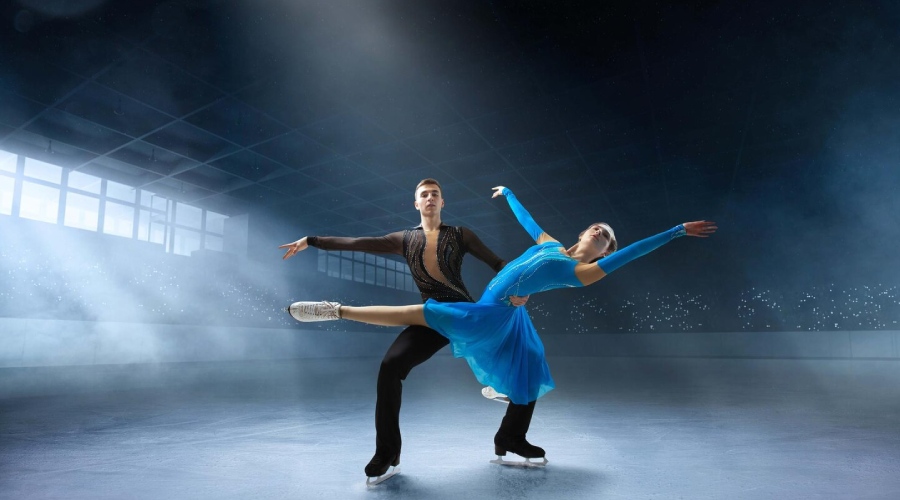
The Dance Advantage
Education keeps on sifting and shifting, ever-evolving; enveloping new ideas into its folds. One such idea that has been gaining a foothold in public schools is that of integrating arts, viz dance, into the broader curriculum. For instance, complex science concepts like Photosynthesis have been made simple and interesting by using dance to convey elements of photosynthesis, including water, sunlight, carbon dioxide, and chlorophyll.
The need:
The genesis of the idea can be traced to the Gurukul times when performing arts were interwoven in the curriculum and the students learned all the art forms from their Guru along with the main subjects. It is again gaining ground. Today, arts education advocates struggle to ensure adequate time and support for the arts in schools—whether music, visual arts, theater, or dance. These subjects are often sacrificed at the altar of the core subjects like Science and Mathematics. For decades, arts education has been treated as though it was the novice teacher at school—the last hired and first fired when times get tough. The issue seems especially pronounced in dance, the smallest of the four art forms which is seen as a second-class citizen.
The rising need to improve test scores in subjects like Maths and Science also makes it imperative for schools to think of ways and means to enhance student learning and thereby test scores. The research substantiates the fact that dance-learning experiences provided for young people in and outside schools impact positively upon young people’s learning in schools, as well as in pre-service and professional development programs for those who teach dance in various settings. Support of major dance organizations as well as the goals of the United Nations Educational, Scientific and Cultural Organisation (UNESCO) affirm the importance of dance education and encourage the research and practice to provide lifelong and intergenerational learning in, about and through dance education.
Integration in early years:
Engagement in the dance provides numerous benefits for learning in the most crucial early years. Basic literacy, numeracy, and scientific concepts are introduced through music, movement, and visual arts making. Social skills, important for tolerance, understanding, and celebration of diversity, are developed through dramatic play, singing, and dancing. Early participation in the dance stimulates children’s imagination and creativity in supporting the development of the brain’s prefrontal cortex, responsible for planning, self-control, reflection and other aspects of ‘higher thinking’.
Dance integration in Middle and Senior school:
Instances of integrating dance, though apparently still quite limited are scattered across different levels of the curriculum. Known as arts integration, innovative teachers use dance to explain mathematical and scientific concepts that many students find too abstract to grasp. For instance, watching ballet or performing basic ballet moves teaches children about shapes, patterns, angles and rotational symmetry. Programs such as Math Dance offer resources and workshops that integrate dance and math.
An integrated approach deepens students’ understanding of math fundamentals, which provides a foundation for advanced math study. Also, dance can be used to teach ideas as diverse as chemical bonding, plate tectonics, and astronomy.
The more schools teach through dance integration, the more they have started realizing how dynamically it brings deep and complex learning to children.
Benefits of Integrating Dance in Curricula:
Improves test scores:
When teachers reinforce academic concepts with dance, students learn more and score higher on standardized tests. Integrating dance on a regular basis into language learning curriculum, for example, necessitates the rich use of the target language to communicate in a variety of contexts and for a variety of purposes. Dancing affords language learners the opportunity to delve into deeper cultural meaning and understanding. Additionally, the regular and purposeful integration of dance into a world language curriculum opens the doors of opportunity for language learners to connect their learning to other disciplines, such as art, history, and even mathematics.
Improves Concentration:
The perennial problem that we all are facing in a high tech world is a snappy concentration. The result – students not being able to cope up with tests and jobs that call for a high concentration. To resolve this issue, schools have come up with longer duration of physical activities. And research proves that they need to do do. For instance, a panel of researchers in kinesiology and pediatrics conducted a review of more than 850 studies about the effects of dance activity on school-age children. Most of the studies measured the effects of 30 to 45 minutes of moderate to vigorous physical activity three to five days a week on many factors — physical factors such as obesity, cardiovascular fitness, blood pressure, and bone density, as well as depression, anxiety, self-concept, and academic performance. Based on the strong evidence in a number of these categories, the panel firmly recommended that students should participate in one hour (or more) of moderate to vigorous dance activity in a day. Looking specifically at academic performance, the panel found strong evidence to support the conclusion that physical activity has a positive influence on memory, concentration and classroom behavior.
Promotes collaboration:
Dance education has important benefits for students’ social relationships, particularly among genders and age groups. Many forms of dance, including ballroom, are inherently social. They involve moving together in synchrony and empathy, with direct physical contact. Research proves that as a result of dancing together, there was a demonstrable improvement in students’ abilities to cooperate and collaborate. In a survey in Los Angeles, 66 percent of school principals said that after being in the program, their students showed an increased acceptance of others, and 81 percent of students said they treated others with more respect. Dance has economic benefits, too. As well as being a field of employment, dance promotes many of the personal qualities that employers recognize as essential in a collaborative, adaptable workforce.
Creates well-rounded personalities:
Integrating dance in the school curriculum enhances social skills that are scarce these days- empathy, resilience, adaptability and the like. It creates well-rounded personalities. However, it should be remembered that art is not only for the gifted, Just as we do not teach math solely to create mathematicians, and we don’t teach writing solely to create the next generation of novelists. The same holds true for the arts. We teach them to create well-rounded citizens who can apply the skills, knowledge, and experience from being involved in the arts to their careers and lives.
Overcomes stage fear:
Modern life with all its gadgets and digital assistants makes it easy for you to become a talking head which includes breathing shallowly and rapidly. The fight or flight response to any kind of fear exacerbates this type of respiration cycle. To counter these habits, learn how to breathe diaphragmatically. Dance preps you for just that. If dance is an integral part of the curriculum, students will be able to overcome stage fear by remaining calm and lowering your heart rate.
Summing up:
Many public schools that have effectively implemented arts integration have either significantly reduced or completely eliminated the educational achievement gap for economically disadvantaged students. Educators all over have started recognizing the fact that dance can be used as a catalyst for learning and creating a well-rounded personality
Therefore, whether you are a student or an educationist, once you know that effective dance integration reinforces classroom learning, you can use it to your advantage and glide ahead…

